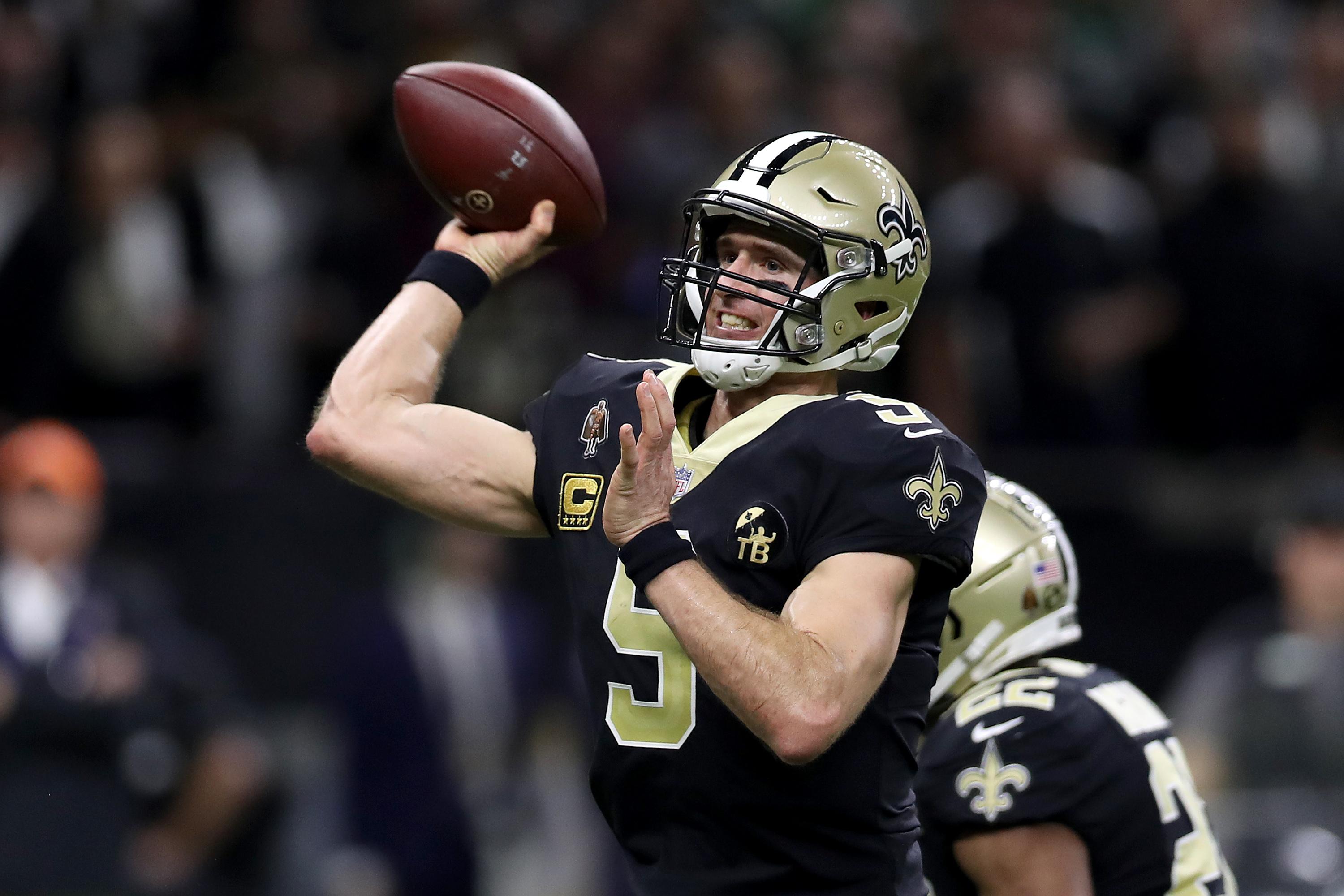
Every possession tells a story, and on Sunday the Saints wrote an epic. On the team’s first possession of the second half, New Orleans embarked on a 112-yard odyssey that spanned 18 plays, took more than 11 minutes off the clock, captured nine first downs, and ended with the first third-quarter touchdown against the Eagles in more than a month. The drive completely reversed the flow of the game, which began with Drew Brees throwing an interception on the first play from scrimmage and following it up with a three-and-out and then two fumbles on back-to-back drives. After going into halftime down 14-10, the Saints righted themselves by taking control of the game with a never-ending drive the way a boa constrictor takes control of its prey. How New Orleans embarked on its 11-minute, 29-second quest in its 20-14 victory over Philadelphia was a microcosm of what New Orleans’s offense is capable of—and hinted at how the Saints will fare against the Rams in the NFC championship game.
No. 1: A Boom-or-Bust Ground Game
The Saints ran the ball eight times for 35 yards on the forever drive, but 15 of those came on the final Alvin Kamara run. The other seven runs gained a combined 20 yards, and four of the eight runs were for 1 yard (two each from Mark Ingram and Kamara). It’s representative of the game as a whole. Ingram finished with nine carries for 53 yards, but take away one 36-yard romp and he had eight carries for 17 yards, which is a disaster.
The lack of production stems from the team’s struggles in the trenches. The Saints offensive line is among the best in the league and perhaps the hidden strength of the offense, but the group struggled mightily with the Eagles’ interior linemen on Sunday in run blocking and pass protection (Brees was sacked multiple times in a game for just the fourth time since Week 5). All-Pro defensive tackle Fletcher Cox wreaked havoc, and that will be a problem next week against the league’s other All-Pro defensive tackle, Aaron Donald. The Saints don’t need to try to be the Rams and rush for 273 yards, but allowing Donald and Co. to dominate the interior will bode poorly for the running attack and the passing game considering the Saints prioritize upholding the center of Brees’s pass pockets.
No. 2: Penalties, the Distant Cousin
The Saints offense had 94 penalties on the season, tied for 27th at 5.9 per game. But on Sunday, they had 11 penalties for 84 yards, including three on the offensive line on this drive as they struggled mightily despite playing at home. It might be the natural consequence of facing a tough defensive line like Philadelphia, but it won’t get easier next week. The Saints escaped a number of manufactured long distances because of the magic of Michael Thomas. (Who picks up 20 yards on second-and-20, honestly?) Left guard Andrus Peat isn’t likely to get less jumpy facing Donald when he had trouble with Timmy Jernigan. First-and-20s would be even more difficult against L.A.’s secondary, which is more experienced than Philadelphia’s and features two premier pick-six artists in Aqib Talib and Marcus Peters.
No. 3: Michael Thomas Is Ole Faithful
Thomas was targeted five times on the drive, and he caught four of those balls. Those four catches were:
- A first down on second-and-9
- A first down on second-and-20
- A first down on third-and-16
- A touchdown on first-and-goal from the 2
Throwing to Thomas is the safest bet in the NFL right now, regardless of situation. He led the league with 125 catches and had the sixth-most receiving yards (1,405), but what stands out about his season is he accrued those numbers with just 147 targets. Thomas caught 85.0 percent of the balls thrown his way, which is the highest catch rate for any wide receiver this season who has been targeted at least 50 times. In fact, it’s the highest figure for a qualifying non–running back since the league started keeping track of targets in 1992. Among players who have more than 100 targets in a season, the gap between Thomas and second-place Wes Welker (who caught 77.2 percent of his targets with the 2007 New England Patriots) is 7.8 percentage points, which is the same as the gap between Welker and Julian Edelman in 2013, who is ranked 81st. Thomas is as reliable as it gets, and he shows up in the biggest moments. Talib and Peters have a tough day ahead of them next week.
No. 4: Unexpected Contributors
Sean Payton has a habit of getting the ball to people you’ve never heard of, and there’s no better example than Josh Hill, a.k.a. Playoff Josh Hill. Primarily a blocking tight end who played more than 60 percent of New Orleans’s snaps this season, Hill has 47 receptions for 459 yards for the Saints in his past 41 regular-season games, the definition of a receiving nonfactor. In last year’s playoffs, however, Hill had six receptions, 103 yards, and a touchdown in two games, making him a legitimate part of the offense. On Sunday, Hill again had three catches (albeit for 7 total yards), but his 9-yard catch on third-and-3 showed the Saints still look to their blocking body in the playoffs.
While Ted Ginn Jr. is not anonymous, he hasn’t been a big factor for New Orleans this season after suffering a knee injury in Week 4 that kept him out until Week 16. But he was the second-most-targeted receiver for the Saints on Sunday, trailing only Michael Thomas. Ginn finished with three catches for 44 yards on seven targets, but the pedestrian stat line hides the magnitude of his return. Not only do the Saints get an experienced vertical threat in Ginn that they had lacked, but they also get a receiver who didn’t play against the Rams in Week 9, which gives Payton flexibility in showing Los Angeles looks on offense that the Rams haven’t seen.
No. 5: Taysom Hill, All-Effort Swiss Army Knife
On first-and-10 at the Eagles 46-yard line, Brees launched a deep ball for … is it a bird? Is it a plane? No, it’s third-string quarterback Taysom Hill, who failed to catch the jump ball but secured a grip on all of our hearts by beating the Eagles secondary on a deep route. Then, on the very next play, Hill stayed on the field as the quarterback and launched a perfect deep pass to Kamara, who pranced into the end zone for a 46-yard touchdown—but a holding penalty on Peat nullified the play and pushed the Saints back 10 yards.
Hill is perhaps the most versatile role player the NFL has seen this decade, and his skill set was captured perfectly on these two plays. There are players who can rip accurate passes as a gadget play, as Jarvis Landry and Odell Beckham Jr. did earlier this year, but there isn’t quite anyone like Hill, who is as capable of beating defenders outside on a speed rush as he is bruising inside for a short-yardage gain or launching a 50-yard pass to a receiver in stride, and apparently he’s added the ability to get separation on 40-plus-yard passes. Hill’s versatility is amazing, and while he didn’t get the 46-yard receiving or passing score, that doesn’t mean the plays weren’t successful. Just putting these plays on tape creates a nightmare for the Rams’ defensive coaching staff, which has to prepare for countless possibilities every time he steps on the field. The more time that Wade Phillips’s staff spends worrying about hypothetical Hill throws is less time spent figuring out how to get Donald in one-on-one blocking situations. And if Hill can (indirectly) help block Aaron Donald, he really can do everything.

